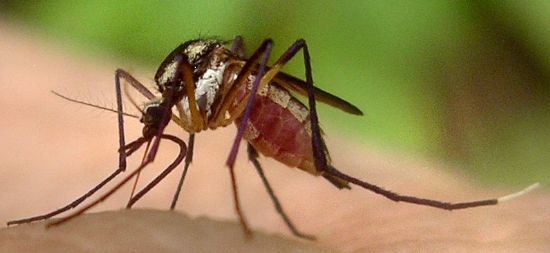by Valerie
July, 2010Mosquito
We have had a very wet summer so far. While many animals are taking advantage of the exceptionally moist conditions, perhaps none is as evident as the mosquito (Psorophora longipalpis). There are a number of different species of mosquitoes and this just happens to be one that I caught "in the act." It was feeding on my hand, which kept it busy long enough for me to take some photos. Some of our mosquitoes are very plainly colored, often brown. There are some, though, with distinctive markings on their bodies and legs. These, along with size, and sometimes other physical characteristics like hairs on legs, shape of proboscis, or marks on wings, make it possible to identify the different kinds, as long as the specimen is not smashed beyond recognition. Mosquitoes are true flies, in the same order (Diptera) as house flies, gnats, midges, and love bugs. Another kind of fly, the crane fly, is often mistaken for a gigantic mosquito, but these large insects never bite. All true flies (as opposed to other insects with "fly" in their name) have just one pair of wings. The other pair has evolved into little knobby organs called halteres that act as gyroscopes to help the fly navigate. The success of this design is evident when one is trying to swat a pesky fly or mosquito that is buzzing around the kitchen. Only female mosquitoes have a taste for blood (males eat nectar). They need it to help their eggs develop, but in obtaining it, they sometimes cause an itchy welt or pass along disease causing organisms. Mosquitoes are attracted to the carbon dioxide that, as living beings, we produce. They may be repelled by some odors and sprays. Good luck. |